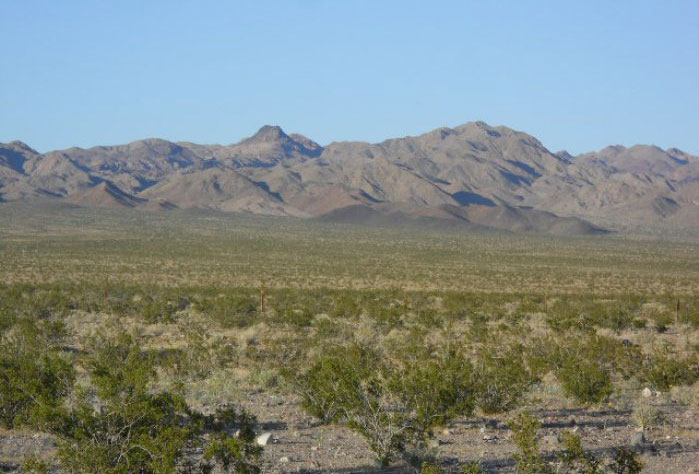^Cady Mountains above the large fan where Calico Solar Project is proposed.
K Road Withdraws Calico Solar Project Application
June 21, 2013 - The California Energy Commission announced today that the solar company K Road canceled its project review for a large-scale photovoltaic array on the alluvial fan east of Barstow, CA. The application was to be amended from a solar thermal project to a photovoltaic project following market trends in inexpensive Chinese PV imports, yet K Road may have decided that the project was still not viable after the close of federal subsidies such as the Department of Energy loan guarantee program and a 30% US Treasury stimulus construction grant. A solar tax credit still applies until 2016, but issues with transmission may have played a part in the decision to pull the project.
K Road stated in their letter to the CEC:
"Due to changed market conditions, we will not be able to move this project forward, either as licensed or as proposed to be amended.
"K Road requests that termination of the license be effective immediately and no later than June 30,2013. We do not believe that there would be any purpose served in incurring or paying for compliance fees for the upcoming fiscal year."
A Solar Programmatic Environmental Impact Statement by the Department of the Interior designates this as a solar exclusion zone, so other applications may not be accepted in this area.
California State Assembly Passes Law to Fast-track Calico Project
May 11, 2012 - The state assembly today passed a specific law clarifiying that the Calico Solar Project may go ahead with environmental review. Governor Brown is expected to sign it. If a solar thermal project was challenged in the California Supreme Court, it has to start over with review. Calico Solar Project was challenged by environmental groups (and the challenge thrown out). This law specifically lifts that requirement just for Calico so it does not have to start over. K Road had originally proposed to build 100 MW of solar thermal Stirling dish technology (which needs approval by the California Energy Commission) and photovoltaic technology to make up the rest of the power plant. The latter technology does not need CEC review, only county approval. K Road has probably opted to build 100% PV and hopes to retain the California Energy Commission do a quick approval, instead of starting all over from the beginning with a new review by San Bernardino County.
A summary of the bill:
AB 1073 (Fuentes)
Energy: solar thermal powerplants: conversion to solar photovoltaic technology.
(1)Existing law vests the State Energy Resources Conservation and Development Commission with the exclusive jurisdiction to certify thermal powerplants. Under the California Environmental Quality Act (CEQA), the certification of a thermal powerplant is a certified regulatory program and is therefore exempt from certain requirements of CEQA. A thermal powerplant does not include a solar photovoltaic electrical generating facility. However, existing law provides that the thermal powerplant certification process applies to owners of specified proposed solar thermal powerplants who are proposing to convert the proposed facility from solar thermal technology to solar photovoltaic technology if the proposed solar thermal powerplant project has been certified by the commission. Existing law provides that the thermal powerplant certification process does not apply to the proposed conversion if the certification of the proposed solar thermal powerplant was timely challenged.
This bill would provide that the thermal powerplant certification process would apply to a proposed conversion of a solar thermal powerplant that was timely challenged if the challenge was subsequently dismissed by the California Supreme Court.
(2)This bill would declare that it is to take effect immediately as an urgency statute.
http://www.aroundthecapitol.com/Bills/AB_1073/20112012/
See also the article in the Los Angeles Times:
http://www.latimes.com/news/local/la-me-solar-calico-20120511,0,2786948.story
Comments Accepted on Modified Calico Solar Project
November 14, 2011 - December 9 is the deadline for public comments on the upcoming Draft Supplemental Environmental Impact Statement. K Road is proposing to modify technology from solar thermal to photovoltaic, and possibly some solar thermal technology, as well as relocate facilites or have new facilities. Bureau of Land Management is preparing this Draft Supplemental EIS and is seeking scoping comments on the Right-of-Way. The comments would be used to prepare an amendment to the existing EIS document.
Phase 1 would include building 275 MW of photovoltaic panels on 1,863 acres, an central services complex, access road, onsite substation, and underground water utility line south of the BNSF rail track. This area has some Desert tortoise and a population of Mojave fringe-toed lizards, as well as cultural sites. Phase 2 would include 389 MW of PV panels and potentially some solar thermal on 2,750 acres north of the rail track on excellent tortoise habitat and rare plant habitat. Construction is proposed to begin early 2013.
See the Southern California Edison proposal for a 70-mile long new large Pisgah-Lugo transmission line.
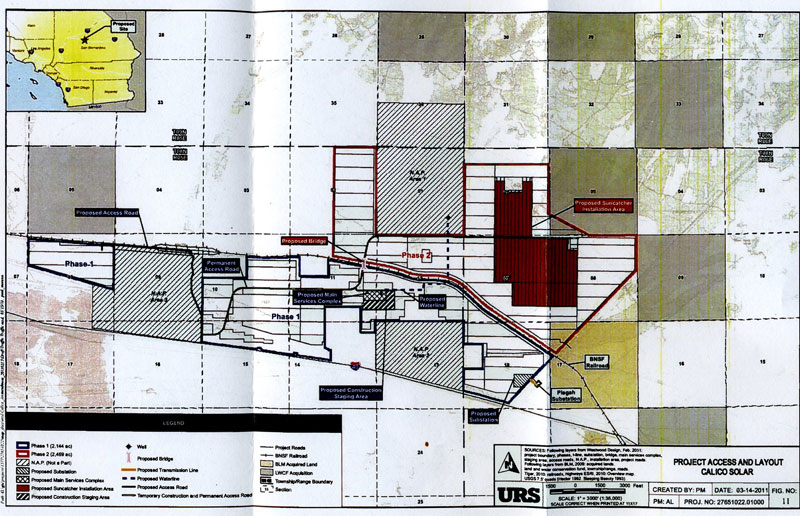
Bureau of Land Management Annouces Action on Project
October 25, 2011 - After a lull in activity, BLM put out a Notice of Intent to prepare a Supplemental Draft Environmental Impact Statement for the Calico Solar Project. Questions will arise due to such events recently as the bankruptcy of Stirling Energy Systems, which supplied the engines for the SunCatchers which were still part of the mostly photovoltaic project.
[Federal Register Volume 76, Number 206 (Tuesday, October 25, 2011)]
DEPARTMENT OF THE INTERIOR
Bureau of Land Management
Notice of Intent To Prepare a Supplemental Draft Environmental Impact Statement for the K Road Calico Solar Project, San Bernardino County, CA.
SUMMARY:
In compliance with the National Environmental Policy Act of 1969 (NEPA), as amended, and the Federal Land Policy and Management Act of 1976 (FLPMA), as amended, the Bureau of Land Management (BLM), California Desert District, intends to prepare a Supplemental Draft Environmental Impact Statement (EIS) for an amendment to the right-of-way (ROW) grant for the K Road Calico Solar Project (Project) in San Bernardino County, California.
DATES: The BLM will provide a 45-day public comment period upon publication of the Supplemental Draft EIS.
ADDRESSES: Web site: http://www.blm.gov/ca/st/en/fo/barstow/K Road_Calico_Solar.html. E-mail: CalicoPV_SEIS@blm.gov. Fax: (760) 252-6098. Mail: Bureau of Land Management, Joan Patrovsky, Project Manager, 2601 Barstow Road, Barstow, California 92311.
FOR FURTHER INFORMATION CONTACT: Joan Patrovsky, BLM Project Manager, or Edy Seehafer, BLM NEPA Compliance Coordinator, telephone (760) 252-6000. Please contact Ms. Patrovsky if you'd like to have your name added to our mailing list. See also ADDRESSES section, above. News media inquiries should be directed to the California Desert District Office, Public Affairs Office, David Briery, 22835 Calle San Juan De Los Lagos, Moreno Valley, California 92553, telephone (951) 697-5220, or e-mail: dbriery@blm.gov.
SUPPLEMENTARY INFORMATION: K Road is seeking approval to construct and operate an electrical generating facility with a nominal capacity of approximately 664 megawatts (MW). The project would use photovoltaic (PV) panels and may include some solar thermal power. Approximately 4,604 acres of BLM-administered public land and 9 acres of privately owned land are needed to develop the Project. K Road has submitted an application to the BLM requesting to amend their ROW grant to change portions of the approved facility from 100 percent SunCatcher technology to PV technology and potentially some SunCatcher technology. On October 20, 2010, the BLM approved the Calico Solar ROW grant, which would develop a solar thermal energy generating facility in a project area north of Interstate 40 between Newberry Springs and Hector, California approximately 37 miles east of Barstow, California.
The grant holder, K Road Calico Solar, LLC has applied to the BLM for a ROW grant amendment on public lands to construct the solar facility in two phases including a change in technology: Phase 1 (275 MW and 1,863 acres) will consist of PV panels, an access road, a central services complex, an on-site substation, and a underground water utility line. Phase 2 (2,750 acres, 389 MW) will consist of PV panels and may include some SunCatcher technology. Construction would begin in early 2013. Although construction would take approximately 48 months to complete, renewable energy power would be available to the grid as each phase is completed. The facility would be expected to operate for approximately 20 years.
A new 230-kV substation would be built in the center of the project area and would connect to the existing Pisgah Substation via an approximately two-mile long single-circuit, 230-kV transmission line. The 2010 Final EIS and Proposed Amendment to the California Desert Conservation Area Plan for the Calico Solar Project considered this type of technology but did not analyze it in detail.
The Supplemental Draft EIS will analyze this alternative in detail, including any additional site-specific impacts resulting from the change in technology and additional ancillary facilities or relocation of facilities. This includes impacts to air quality, biological resources, cultural resources, water resources, geological resources and hazards, hazardous materials handling, noise, paleontological resources, public health, socioeconomics, soils, traffic and transportation, visual resources, waste management and worker safety and fire protection, as well as facility design engineering, efficiency, reliability, transmission system engineering and transmission line safety and nuisance.
If the ROW amendment is approved by the BLM, a multi-technology solar power plant facility on public lands would be authorized in accordance with Title V of FLPMA and the BLM's ROW Regulations at 43 CFR part 2800.
A certificate designating approval by the California Energy Commission must be obtained by K Road before it may construct the portion of Phase two involving "SunCatcher'' solar facilities.
More Lawsuits
August 25, 2011 - After a Sierra Club lawsuit was thrown out of the California Supreme Court on issues concerning alleged project violations of the California Environmental Quality Act, the group is giving notice that it intends to sue on National Environmental Policy Act concerns, against the Department of the Interior and US Fish and Wildlife Service.
Here is today's press release:
Controversial solar power plant challenged by conservation groups
Conservation groups urge Interior Department to move the Calico Solar Project to less sensitive lands
WASHINGTON (Aug. 25, 2011) — A coalition of conservation groups made a last-ditch appeal to Interior Secretary Ken Salazar today, urging the Bureau of Land Management to move the Calico Solar Project from vital desert habitat to degraded lands that could produce the same amount of energy, but pose less risk to imperiled wildlife and the environment.
“The conservation community wants to see clean energy projects succeed, but development has to be done smart from the start, where projects are designed up front to avoid, minimize and mitigate impacts on wildlife and the environment. The Calico Solar Project is a glaring example of the wrong way to pursue solar energy projects,” said Kim Delfino, California Program Director for Defenders of Wildlife. “The harm to imperiled wildlife, plants and fragile desert habitat caused by this project if it is built in this location seriously outweighs any benefits. And while we’ve worked successfully with a number of large-scale solar project developers to reduce their project’s impacts on the environment and supported other projects with no changes, the impacts of this project are too great in its present location. As we have done successfully with other solar developers, we hope we can find a way to modify this project to reduce its impacts and permit it to proceed.”
The groups have notified the Interior Department of their intention to file a lawsuit against BLM and the U.S. Fish and Wildlife Service for approving the 4,613-acre solar power facility, which will impact seven imperiled species in the fragile Mojave Desert landscape, including desert tortoise, burrowing owls and bighorn sheep.
But the groups hope to work out an agreement with the project’s developer, K-Road Power, and BLM outside the courts if the developer is willing to move the project to less sensitive lands. The groups have pointed out that the project could work well on mostly private lands -- including some degraded agricultural lands and former industrial sites, called brownfields, that are close the current site, but outside of the sensitive Pisgah Valley.
The California Energy Commission found that these alternative sites would be a good option for the project and would likely result in fewer impacts on wildlife and the environment. But BLM and the project developer at the time, Tessera Solar, rejected these locations.
Together, Defenders of Wildlife, the Natural Resources Defense Council and the Sierra Club have worked out agreements with developers to resolve concerns over four projects on public lands, resulting in the permitting of some 2,595 megawatts -- nearly 90 percent of the solar energy to be built on BLM lands in California. Despite the groups’ strong track record of working with developers to reduce impacts on wildlife and natural resources, K-Road Power has been unwilling to consider a less environmentally damaging alternative.
“The area where the Calico project is currently planned is simply not appropriate for renewable energy development,” said Barb Boyle, Senior Representative for the Sierra Club’s Beyond Coal campaign. “If built in this location, the Calico project will unnecessarily sacrifice important and irreplaceable wildlife, plants and habitat. Especially when there are ample disturbed and/or degraded sites throughout California that are appropriate for renewable energy development, selecting this specific land for the project has created a preventable conflict between the project’s developers and Californians who want to preserve our state’s native wildlife and landscapes. There is still time to get this right and we hope to work with K-Road Power to find an alternative location that has far fewer impacts on wildlife and desert ecosystems.”
The NOI letter to Department of Interior >>here.
----------------------------------------------------------------------------------------------------
A California Energy Commission business meeting agenda document indicates the rail company BNSF may also be suing Department of Interior and the California Energy Commission in US District Court, Riverside County, California.
Energy Commission Agrees to Review Whole Project
July 19, 2011 - The California Energy Commission held a status conference to hear arguments this morning about whether the Energy Commission will review and license the photovoltaic part of K Road's Calico Solar Project, 85% of the project, and not just the SunCatcher portion. The lawyers were going at it, siting case precedence. The CEC recently decided to not take the Ridgecrest Solar Power Project application by Solar Millennium, because it was redesigned to be 100% PV. The CEC only licenses thermal projects. But today they seemed to lean on accepting K Road's whole project, including a review of the PV portion.
The CEC agreed that it will probably be the lead agency for the PV part, and do a separate but parallel environmental review under the California Environmental Quality Act. They will prepare a new Environmental Impact Report for the PV part of the project, but just a supplement to the original Staff Assessment for the solar thermal part. They base this on the fact that the two parts of the project share a commonality of access roads and transmission. Therefore the project is one project, not two separate projects. The good thing is this EIR part will have to go out for public comment. Otherwise California Department of Fish and Game would be the lead CEQA agency for the PV part of the project. DFG is following this process and said it would send written comments next week on its response to the question of who will be the lead agency.
K Road will be asked to pay a fee to the Energy Commission for the EIR for their PV part of the project, over and above the completed staff assessment for the original project. They objected. They want no new review, and say the project is not new from Tessera's original Stirling dish project.
Sierra Club presented arguments that DFG should be the lead agency for the PV portion of the project, and environmental review should start from scratch. They said they generally agreed with the parallel process of two environmental documents, but that it could be one EIR, with CEC's license for the solar thermal part of the project as an appendix. The rail company BNSF generally agreed with Sierra Club.
K Road disagreed, saying DFG has only limited authority, it will only issue an Incidental Take Permit for threatened and endangered species, and only CEC has broad authority to review land use.
CEC said it will wait on a final determination until DFG's letter was in hand.
K Road Mofifications to Calico Solar Project Still Have Problems
April 18, 2011 - On March 22, 2011, Calico Solar, LLC filed a petition with the California Energy Commission requesting to modify the Calico Solar Project (CSP). The 663.5-megawatt project was certified by the Energy Commission on December 1, 2010. The proposed project will be constructed on an approximate 4,613-acre site located in San Bernardino County, California.
The Calico Amendment does not propose to change the size, boundary, or generating
capacity of the Energy Commission-approved project. It proposes a modification in the
solar collector technology used on the site. The proposal would generate 100.5
megawatts of power using SunCatcher technology and 563 megawatts using single-axis
tracker photovoltaic technology.
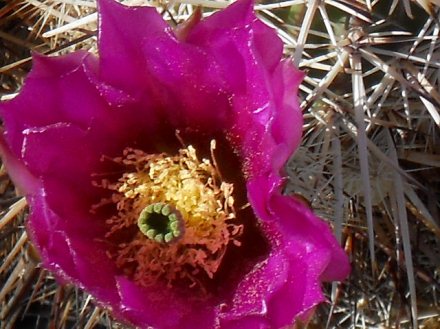
^Beavertail (Opuntis basilaris) on the project site.
The amendment proposes to alter the phasing of the project to reduce access issues
associated with the northern portion of the site. Phase 1 will be located primarily south of
the railroad line and will include the main access road, the main services complex, the onsite substation with a shorter transmission line interconnecting with the Pisgah Substation, a water well (located north of the railroad), a water line and a portion of PV solar collectors. Phase 2 will be located entirely north of the railroad and will include the
remainder of the PV solar collectors and the SunCatchers. The SunCatchers will be
located toward the center of Phase 2 to reduce the noise impacts on wildlife and the glint
and glare concerns.
The tracker blocks are made up of approximately 19 rows containing approximately 48 PV modules, totaling over 900 modules per tracker block. A basic tracker block will measure approximately 280 feet by 170 feet and occupy a space of approximately 1.1 acres. The size of each tracker block may be reduced as required by site characteristics such as boundaries, roads, topography, or similar constraints.
The modules being considered for this modified project are produced by a number of companies in this industry. Among them are SunPower, Suntech, Yingli, Q-Cells, Trina, and other manufacturers of silicon crystalline modules. For reasons of availability to support the modified project delivery requirements, multiple sources might be utilized, which is a common practice in the industry. Modules are generally quite similar in their physical and performance characteristics. They tend to be about 77 inches tall, 40 inches wide, and 2 inches thick and weigh approximately 55 pounds. Each module is encapsulated with tempered glass (or similar transparent material) on the front surface, with a protective and waterproof material on the back. The edges are sealed for weatherproofing, and there is often an aluminum frame holding everything together in a mountable unit. On the back of the module, there is a junction box, or wire leads, providing electrical connections.

^Prickly poppy (Argemone munita) on the project site.
A typical row consists of 48 PV modules attached to a horizontal steel shaft. These shafts are supported by 4.5-inch-diameter vertical steel posts that are spaced approximately 12 to 15 feet apart. The steel shafts are connected by a main drive shaft, which is supported by 6-inch-diameter steel posts. Both the 4.5-inch and the 6-inch steel posts generally project 5 to 6 feet above the ground and are vibrated to a roughly equivalent depth into the ground. To account for minor ground surface differences, instead of grading, the steel posts would vary in height above the ground surface more than the 5 to 6 feet mentioned above in order to create a level tracker block. At maximum tilt, the modules will be at least 3 feet from the ground surface as well as 3 feet above the shaft, for a total height of approximately 9 feet.
The energy produced by each tracker block is directed to one of the approximately 282 inverter pads. Each 2 MW inverter pad is approximately 33.5 feet by 15 feet and will contain two or more inverters, one step-up 450 volt to 34.5 kV transformer, and one main line distribution switchboard mounted on a foundation. As a result of the recent increases in the size of PV projects, inverter suppliers are actively developing larger units to allow fewer inverters per MW.
While the construction activities and methods proposed for the modified project would be similar to those described under the approved project in the Commission Decision, the intensity of the construction activities would be reduced under the modified project. Installation of steel posts to support PV modules would not require the same heavy equipment as is required for SunCatcher pedestal and dish installation. Also, because PV technology does not require intense on-site assembly, the size of the workforce required during construction of the modified project would be reduced from the workforce required under the approved project. As a result, fewer construction vehicles would be needed for the modified project. The construction of the modified project is expected to take approximately four years, however, power could be available to Pisgah Substation as each tracker block or group of SunCatchers is completed. As with the approved project, temporary power would be supplied by generators during construction of the modified project.
The Petition to Amend the Calico Solar Project:
http://www.energy.ca.gov/sitingcases/calicosolar/compliance/2011-03-25_Notice_of_Receipt_Petition_to_Amend_TN-60112.pdf
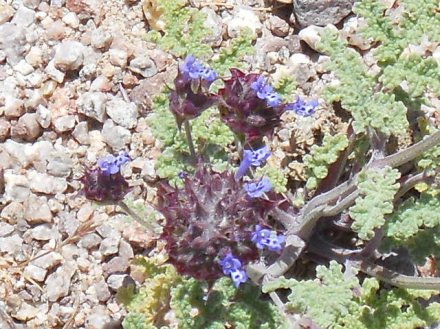
^Chia (Salvia columbariae) on the project site.
Environmental groups and BNSF rail company have continuing concerns with the project. The California Energy Commission claims all issues can be resolved before September, when they hope to make a decision to license the project and allow contruction activities to begin, enabling K Road to obtain a large Department of Energy loan gurantee and American Recovery and Reinvestment Act grant covering 30% of construction costs. On April 14, 2011, the Energy Commission released an Issues Statement, identifying unresolved problems with the project that the new applicant, K Road, needs to address:
1. Tortoise Translocation - changes to the translocation plan and biological opinion are allowed under the current approved translocation plan and based on new available information regarding tortoise translocation and the availability of additional acreage in the Pisgah Area of Critical Environmental Concern (ACEC) for translocation of animals. The Pisgah ACEC is considered a "potentially superior translocation area" to the Ord-Rodman Desert Wildlife Management Area (DWMA) identified in the approved translocation plan. To accommodate these discretionary changes, the translocation plan will need to be edited and approved by the agencies prior to the start of hearings on the amendment so that the public can have adequate review of the revised plan.
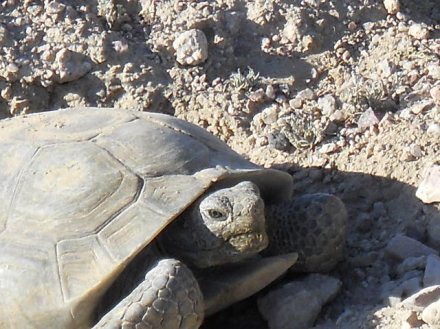
^Adult female Desert tortoise (Gopherus agassizii) on the upper fan slightly north of the proposed Calico Solar Project, seen April 2011.
The agencies will require a survey of the proposed translocation area in the spring of 2011 and subsequent blood testing of any tortoise found during surveys under the amended translocation plan and biological opinion. The requirements for survey of the proposed translocation area and blood testing of the resident population within the proposed translocation plan in the spring of 2011 is already required in the approved translocation plan. Therefore, this measure is not a change with the exception that testing would occur primarily in the Pisgah ACEC instead of both the Pisgah and the Ord-Rodman DWMA. In addition, the agencies have suggested that the applicant conduct spring surveys for tortoise, including blood testing, within the new Phase 1 area of the project. The surveys within the project area may allow the applicant to complete the tortoise translocation process in September of 2011 rather than holding animals over the winter in pens. Holding animals in pens during winter months is currently allowed in the approved translocation plan and biological opinion, but is not biologically preferable. The survey of the new Phase 1 within the project area is being left to the discretion of the applicant with the understanding that they may not be able to complete the translocation process in September of 2011 without conducting spring surveys and blood testing.
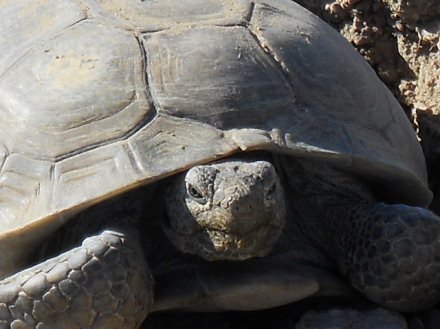
^Female tortoise.
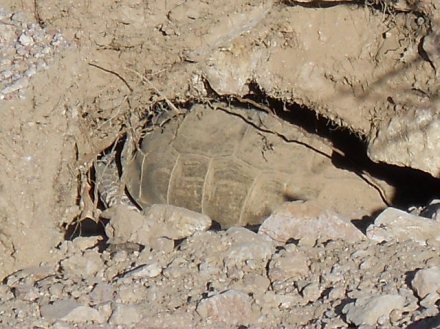
^Large male tortoise in burrow just north of the proposed project site on the upper fan, near the female.
2. Rare Plant Surveys - Due to changes in the phasing design between the approved project and the project amendment, portions of the new Phase 1 area did not have fall plant surveys conducted in the fall of 2010. Fall plant surveys will be required for those previously unsurveyed portions of the new Phase 1. This could impact the construction schedule for 2011 depending on when the surveys can be conducted and whether the surveys find additional special-status plants within the Phase 1 project area. Construction within portions of Phase 1 that have been previously surveyed for fall plants would be allowed to proceed.
3. State Protected Desert Washes - Commission staff will need detailed information on how impacts to state waters were calculated under the proposed amendment and if they represent all potential impacts to jurisdictional features from project construction and operation. It was the previous understanding of staff that PV modules would be less likely to avoid impacts to state waters as compared to the selective placement of SunCatchers. The applicant is currently estimating that the impacts to state waters will decrease under the amendment as compared to the approved project. Depending on the outcome of the data requests for this item, additional fieldwork may be required to complete the final impact calculation for state waters from the proposed amendment. The applicant can perform this work at any time of year, so they should be able to schedule any needed fieldwork so as to avoid impacting their construction schedule for the fall of 2011.
4. Final Drainage, Erosion, and Sedimentation Plan Needed - The project site is traversed by numerous drainages that convey intermittent flash flood flows. Site development could affect these flows and result in downstream erosion and sedimentation that could have significant impacts on environmental resources. Flood flows could also impact solar panel and SunCatcher foundation elements, assembly and maintenance buildings, vehicle access roads and potentially impact the BNSF railroad. Detailed grading and drainage control plans need to be developed for the project that address these potential impacts and provide mitigation measures that will render these hazards less than significant, both as a protection to the environment and to existing infrastructure (BNSF), while assuring the continued dispatchability of the renewable energy source. Due to unsuccessful attempts by the project owner to satisfy these issues in the initial project, staff is concerned about the time required to develop the detailed final drainage, erosion and sediment control plan required for project development. Staff has and will continue to address these issues through data requests to the applicant.
5. BNSF rail Right-of-Way Access - The identified water supply for the project is a groundwater well located on the north side of the BNSF railway. Phase one of the project is proposed for an area south of the BNSF railway. Currently, there is no access agreement between the project owner and BNSF that allows the project owner to access the BNSF right-of-way. Therefore, there is no access by the project owner to the project’s water supply well. Similarly, there is no agreement allowing a water conveyance pipeline across the BNSF right-of-way. The project owner has filed a lawsuit with the California Public Utilities Commission requesting forced access of the railroad right-of-way, and independent negotiations between the project owner and BNSF are ongoing. However, at this time, the access issue has not been resolved.
6. Glint and Glare Study - Glint and glare could result from reflections of the sun on the surfaces of the PV modules and SunCatcher mirrors. Staff is concerned about potential significant impacts of glint and glare on users of the nearby traffic and transportation system. BNSF’s railroad tracks run through the Calico project site, potentially exposing train engineers to glint and glare impacts. Motorists using Interstate 40 and National Trails Highway, just south of the project site, and any other roadways within view of the project, could also be impacted by glint and glare from the PV modules and SunCatchers. Potential glint and glare impacts include retinal burn, flash blindness, veiling reflections and distracting glare, which could interfere with the train engineers’ and motorists’ abilities to safely operate trains and vehicles, respectively.
To explore these potential impacts, staff is requesting that the project owner provide a glint and glare study. Staff included in the data request details of the required study and will work with the project owner and BNSF to support the development of the study.
On April 20 the Energy Commission will hold a site visit and informational hearing in Lenwood for Calico Solar Project.
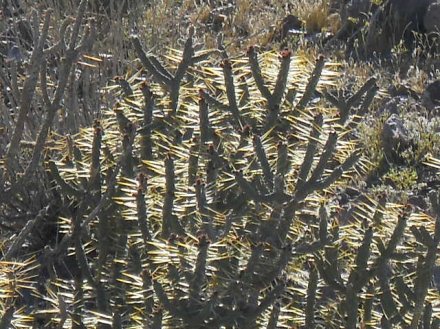
^Pencil cholla (Cylindropuntia ramosissima) on the project site.
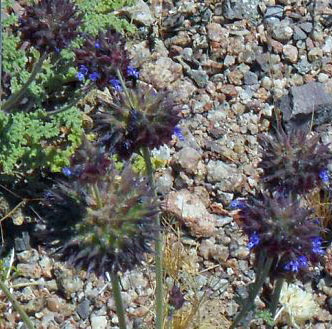
^Chia (Salvia columbariae) on the project site.
Sierra Club Lawsuit Denied a Hearing by California Supreme Court
April 14, 2011 - Without comment, the California Supreme Court denied a hearing for Sierra Club's lawsuit against the Calico Solar Project because of violations against the California Environmental Quality Act, involving Desert tortoise, bighorn sheep, and other wildlife. See more on this lawsuit >>here. The lawsuit was brought at the end of the California Energy Commission hearings with Tessera Solar as the applicant, but since then Tessera sold the project to K Road, which however, has done little to change impacts on the environment at the site. Very few cases are heard by the court, and environmental cases have a particularly hard time getting through. California Unions for Renewable Energy's lawsuit against Calico Solar Project was also thrown out.
http://www.desertdispatch.com/news/calico-10678-project-lawsuit.html
Calico Solar Project
February 25, 2011 - Newberry Springs, California.
Calico Solar Project Open House:
K Road, the 10-year-old solar and wind development company that bought the project rights from Tessera Solar, held a public open house on February 9 in the Newberry Springs Community Center. K Road purchased the project on December 24, 2010 from Calico Solar LLC. K Road has over 1,500 MW of photovoltaic projects in various stages of development.
K Road plans on using single-axis tracking photovoltaic panels over most of the site. Single-axis trackers could be manufactured by any Chinese panel-maker such as SunPower. K-Road is building ten large utility scale projects, mostly on Indian Reservations.
The project consist of 563 megawatts (MW) of photovoltaics, and 100.5 MW of SunCatcher dishes - 4,000 units. Department of Energy requires some "demonstration technology" to obtain their loan guarantee, thus the inclusion of the SunCatchers. SunCatchers would be built in Phase 2.
Total disturbance to the Mojave Desert vegetation, washes, and natural desert pavement would total 1,612 acres north of the BNSF railway, and 1,125 acres south of the rail track. Construction disturbance would include photovoltaic panel modules (991 acres), SunCatchers (only north of the track, 454 acres), new roads (223 acres), 70-foot-long unimproved module access points between every other row of panels to be used by pickup truck four times a year (996 acres), inverters, new substation (15 acres), laydown/storage area (30 acres), and the Main Services Complex 20 acres).
Phase 1 would be moved south of the railroad, while SunCatchers would be moved farther north of the rail in Phase 2, to minimize glint and glare to engineers. A Main Access Road would be built from Hector Road to the rail tracks. Phase 1 would include up to 275 MW of photovoltaic.
Phase 2 would include up to 288 MW of photovoltaics and 100.5 MW SunCatchers. A bridge would be built over the railroad and the main access road continued north of the tracks. Hydrogen generation, storage, and distribution systems would be constructed for the SunCatchers.
They are negotiating new Power Purchase Agreements with SCE, PG&E, and others.
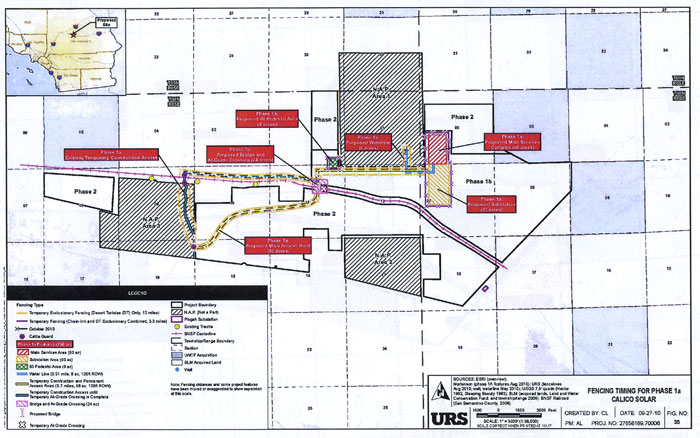
^New site layout (lined areas are Not A Part zones of Catellus lands purchased for land conservation).
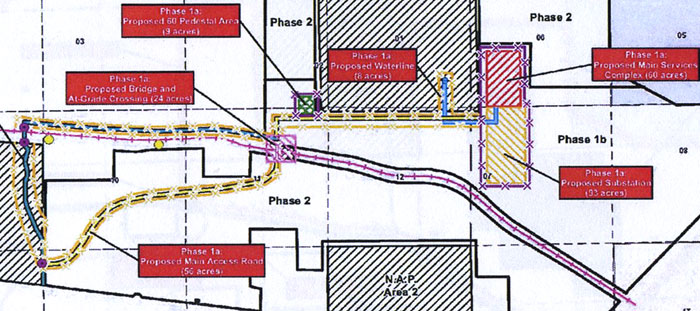
^Detail of above map, showing Phase 1a substation (93 acres) in yellow lines, Main Services Complex (60 acres) in red lines; the blue line is a proposed new waterline from an existing well, and proposed new main access road with proposed bridge over the BNSF rail tracks in yellow and pink.
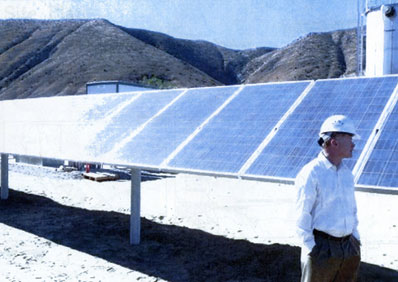
^Single-axis tracking photovoltaic panels.
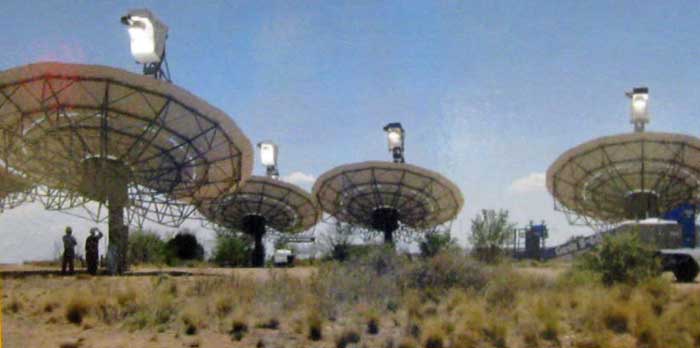
^4,000 SunCatcher solar thermal dish-engines will also be used, according to K Road. They will be in 1.5 MW modules.
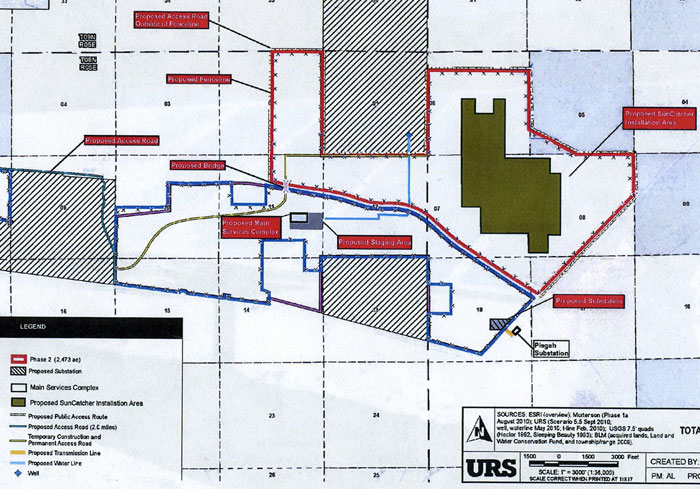
^Area in dark green is the proposed SunCatcher Installation Area.
This new project is being touted as far more environmentally friendly than the Tessera design, with less noise, less raven perches, but they still do not know how to control potential flooding.
K Road said it will use the same wells as Calico Solar LLC proposed, for water usage. They plan to use 22 acre-feet/year, which would be less than for the Tessera project, for washing and dust control.
A new hydrology study is required. K Road will no longer avoid washes, and will build no detention basins. But this was a big issue with BNSF, who worried about damage to their tracks from increased erosion due to thousands of acres of desert surface disturbance up-slope from their grade and wash crossings.
K Road plans to leave a lot of vegetation and they will trim it instead of removing it. A White-margined beardtongue Plant Protection and Monitoring Plan is still under preparation, but will be a significant compliance item.
The Desert Tortoise Relocation/Translocation Plan is also being revised, as are a Final Burrowing Owl Relocation Management Plan, Avian Protection Plan, Revegetation Plan and Closure Plan.
For the Mojave fringe-toad lizard, K Road has left open a small connectivity corridor, but it will still be surrounded by PV panels. Asked how that would protect the source of the habitat, the windblown sand, K Road answered that they are still working on that.
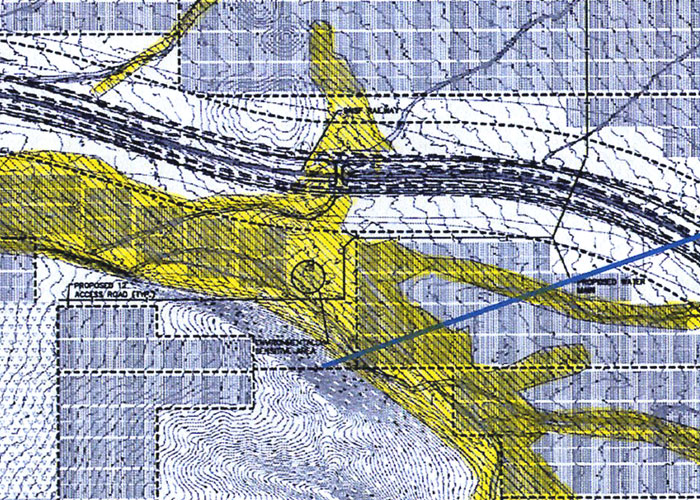
^K Road is proposing to place photovoltaic arrays in sand washes (in yellow) that are both flood zones and good-quality Mojave fringe-toed lizard habitat.
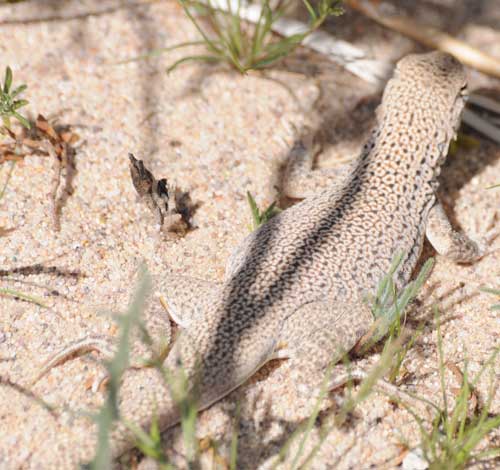
^Mojave fringe-toed lizard photographed on the Calico Solar Project site in the yellow sand wash area depicted in the map above.
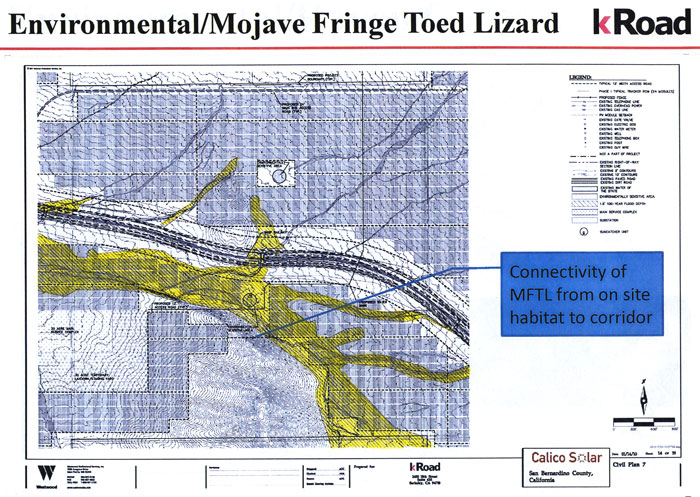
^A narrow "connectivity corridor" at this location will not mitigate the destruction of the sand washes that are excellent permanent habitat for the lizards. We are unsure what this corridor connects to.
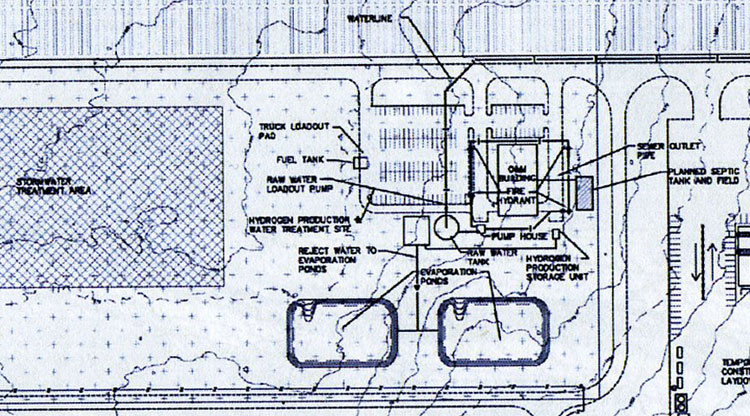
^Plan of Main Services Complex, showing hydrogen production and storage areas for the working fluid (a gas) for the SunCatcher units.
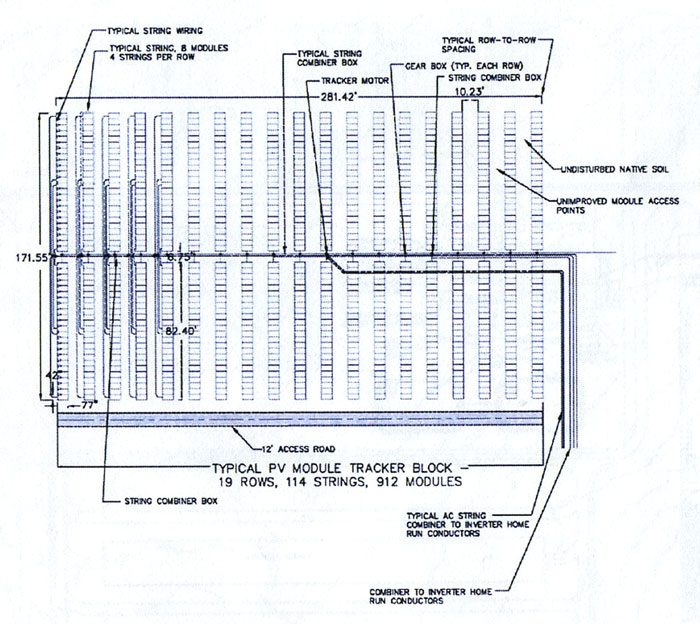
^Photovoltaic module tracker block. Typical blocks have 19 rows of 912 modules. The area between tracker rows will alternate between native soil and unimproved module access points, for maintenance and washing of the panels four times a year.
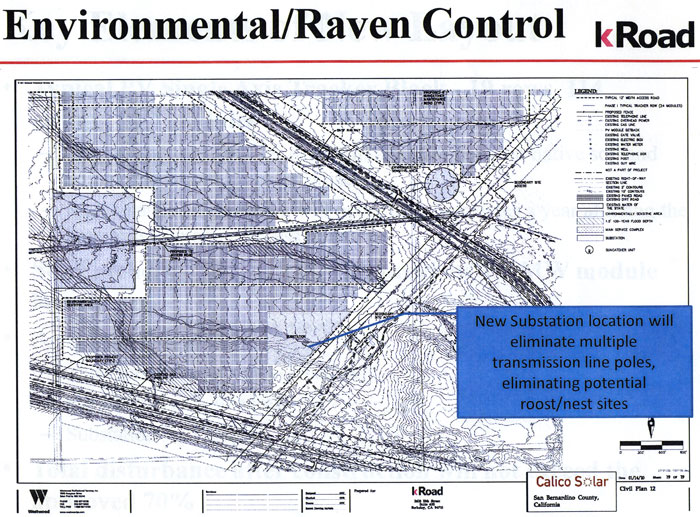
^Eastern part of project with substation location.
K Road says it will have 60 to 100 employees for operation. The company still plans to apply for an American Recovery and Reinvestment grant to cover 30% of construction costs. They plan on undertaking tortoise clearance surveys and fencing by September 2011.
As for the four lawsuits, K Road hopes to work out the BNSF request for injunction (not yet a true lawsuit), they are negotiating a labor agreement with California Unions for Renewable Energy on their lawsuit, they are "talking" with the Sierra Club, and K Road claims the La Cuna de Aztlan lawsuit is not a legitimate tribal suit (however, La Cuna does have a legitimate Memorandum of Understanding with Bureau of Land Management we note).
Whether the licensing case will be merely worked out with an amendment to the Tessera approval with California Energy Commission, or whether the case will have to be re-opened with hearings is unsure.
K Road claims BLM would not need a new Environmental Impact Statement but only an amendment. We believe it is best to insist that BLM do a new EIS. When contacted for comment about what level of environmental review would be undertaken, Jim Stobaugh, National Project Manager for BLM, told us: "BLM was not aware of, nor invited to the Newberry Springs meeting, so there was no BLM position expressed at the meeting. BLM is aware of the sale of Calico Solar LLC and the Project to K-Road Power. We have not received an application requesting the right-of-way be amended. Unless we have such
an application (proposal) including revised plan of development, we won't speculate on what level of NEPA analysis may be required, consultation(s) required, possible decision rendered, nor how long it may take at this point" (February 14, 2011).
Moapa Project in Nevada
K-Road is going for 2,000 acres of photovoltaic panels on desert habitat north of Las Vegas, this time on the Moapa Paiute Reservation.
A public scoping meeting was held at the Moapa Paiute Reservation on February 23, and at the BLM offices in Las Vegas on February 24.
The project would consist of up to 350 MW on 2000 acre footprint plus 50 acres for a Right of Way. Single axis tracker photovoltaics would be built in three phases build and connect to the Crystal substation. Half a mile of new transmission line would be constructed on BLM land.
The project would be located in the mid-section of the southern end of the reservation, almost directly across from the travel plaza on Interstate 15. K Road is looking to sell to California, with Southern California Edison or Los Angeles Department of Water and Power. NV Energy is not central to their planning.
Environmental review will be required under the National Environmental Policy Act with Bureau of Indian Affairs taking the lead, and Bureau of Land Management coordinating.
K Road expects a Record of Decision by November 2011.
Species of concern include desert tortoise; but there is said to be "very little vegetation outside of cactus." No rare plants such as poppy, milkvetch, sticky ringstem, Las Vegas buckwheat, nor penstemon. It's "up on the mesa," very flat and wind-swept. "Even a rabbit would have to pack a lunch to go there."
The Tribe has 2500 acre-feet/year and 800 afy of water lease rights, and there is pending action between the Tribe and the state engineer. There may be concerns with the Moapa Dace habitat nearby, depending on how much groundwater is pumped.
The Notice of Intent is in the Federal register:
A Notice by the Indian Affairs Bureau on 02/04/2011:
The proposed Federal action, taken under 25 U.S.C. 415, is the BIA approval of a solar energy ground lease and associated agreements entered into by the Moapa Band of Paiute Indians with K Road Moapa Solar LLC (K Road), and associated approval of rights-of-way and easements, for K Road to construct and operate an up-to 350 MW solar photovoltaic electricity generating facility located entirely on Moapa tribal lands. The Moapa Band of Paiute Indians may use this EIS to make decisions under the Tribal Environmental Policy Ordinance. The BLM may use this EIS to support a decision for a proposed approximately 0.5 mile right-of-way across Federal public lands adjoining the Moapa River Indian Reservation. The right-of-way may be used to link the proposed solar generation facility to an existing substation on a transmission line with a rating up to 500 kilovolts. The USFWS may use this EIS to support its decisions under the Endangered Species Act.
The purposes of the proposed action are to: (1) use the Tribe's solar energy resources and complete a transmission line from the existing electrical grid to the Tribe-owned travel plaza on Interstate 15 (thereby reducing or eliminating the use of diesel-powered generation at the plaza, improving and diversifying the economy of the Moapa Band of Paiute Indians, and providing other benefits to their members in an environmentally compatible manner); and (2) generate clean, renewable electricity that can be efficiently connected to existing transmission lines to help utilities in the region meet their renewable energy goals.
The EIS will assess the alternatives to, and the environmental consequences of, BIA approval, under 25 U.S.C. 415, of a proposed solar energy ground lease and associated agreements between the Moapa Band of Paiute Indians as lessor and K Road as lessee. The ground lease will enable K Road to construct and operate an up-to 350 MW solar photovoltaic electricity generating facility on approximately 2,000 acres of tribal lands held in trust by the United States and located on the Moapa River Indian Reservation, Nevada. The facility will utilize transformers to step up the voltage to interconnection voltage, which will facilitate a connection of the facility with one or more of the following: an existing transmission line on tribal lands (up to 500 kV); the existing 230 kV Crystal substation operated by NV Energy outside tribal lands; and/or the existing 500 kV Crystal substation operated by NV Energy outside tribal lands. The Crystal substation complex is located on BLM land, approximately 0.5 mile from the southern border of the Moapa River Indian Reservation. The proposed BIA actions include approval of the solar energy ground lease and associated agreements, and approval of rights-of-way and easements on the Moapa River Indian Reservation for K Road to construct electric transmission lines and other supporting facilities for one or more interconnections.
K Road has requested the BLM to approve a right-of-way across approximately a 0.5 mile of Federal public lands in Township 17 South, Range 64 East, Section 10, for purposes of constructing an electrical transmission line to connect the solar generating facility and electric transmission on the Moapa River Indian Reservation with the Crystal substation.
K Road intends to construct and operate the solar facility for a period of 35 years, with an option to renew the lease for another 15 years, if mutually acceptable to the Moapa Tribe and K Road. This area is located in Clark County, Nevada, approximately one mile west of Interstate 15 and approximately 30 miles northeast of Las Vegas, Nevada.
The proposed solar facility will be built in phases of 50 to 100 MW each to meet the needs of offtakers or utilities, up to a total of 350 MW. During the construction of each phase, photovoltaic panels will be affixed to the earth using concrete posts, concrete ballast, or other suitable foundation design techniques appropriate to the topography and site conditions. Some or all of the panels may employ trackers to track the sun during the day. No water will be used in the production of electricity. Water will periodically be used for cleaning the photovoltaic panels during routine maintenance, administrative and sanitation uses at the site (e.g., water in a small office on site), and fugitive dust control.
As lead agency, the BIA will have authority over decisions regarding the EIS and BIA's approval of the solar energy ground lease and associated agreements. These decisions will be documented in a Record of Decision (ROD). BLM will have authority over approval of the off-reservation right-of-way, documented in its ROD. Cooperating agencies, including BLM, will provide expertise and data for their resources of interest and will aid in the development of alternatives and mitigation measures that will minimize or prevent significant adverse impacts.
Significant issues to be covered during the scoping process may include, but would not be limited to: air quality, geology and soils, surface and groundwater resources, biological resources, threatened and endangered species, cultural resources, socioeconomic conditions, land use, aesthetics, environmental justice, and Indian trust resources.
PUBLIC COMMENTS:
Written comments on the scope and implementation of the proposal must arrive by March 7, 2011. You may mail, e-mail, hand carry or fax written comments to either Ms. Amy Heuslein, Regional Environmental Protection Officer, BIA Western Regional Office Branch of Environmental Quality Services, 2600 North Central Avenue, 4th Floor Mail Room, Phoenix, AZ 85004-3008; telephone: (602) 379-6750; fax: (602) 379-3833; e-mail: amy.heuslein@bia.gov; or Mr. Paul Schlafly, Natural Resource Officer, BIA Southern Paiute Agency, 180 N. 200 E., Suite 111 or P.O. Box 720, St. George, UT 84771; telephone: (435) 674-9720; fax: (435) 674-9714; e-mail: paul.schlafly@bia.gov.
-----------------
See also http://edocket.access.gpo.gov/2011/pdf/2011-2554.pdf
